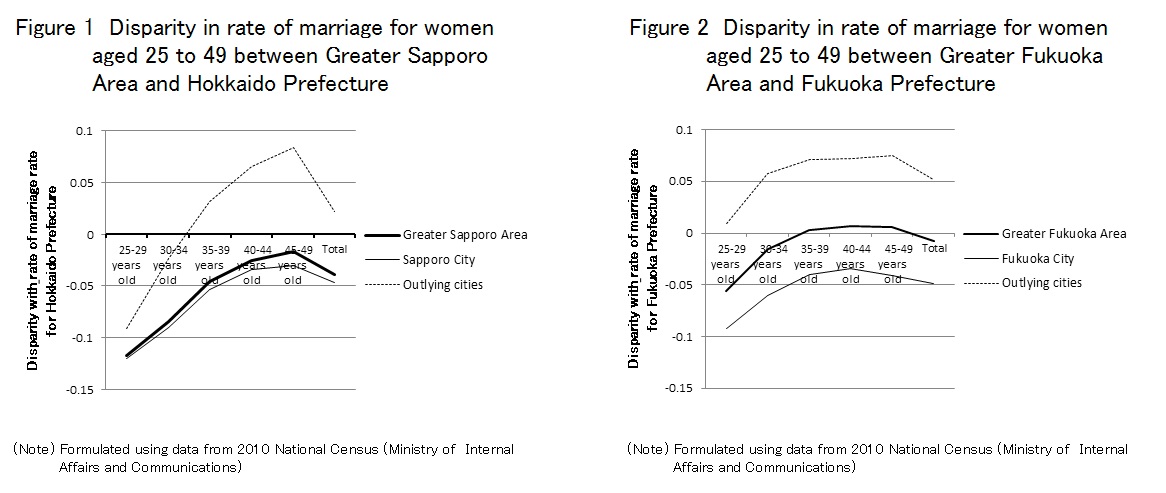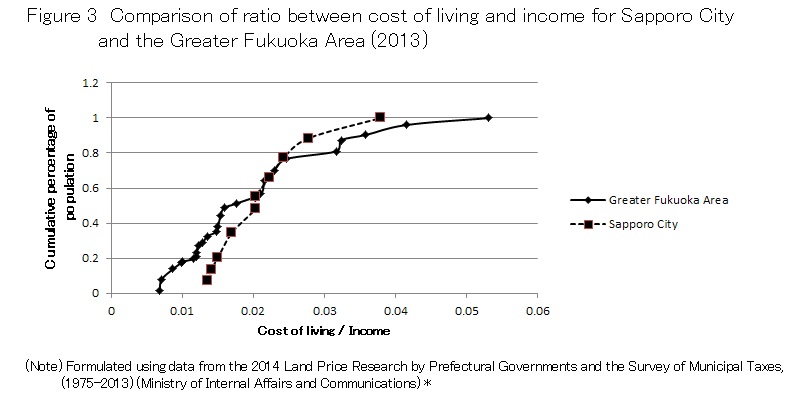 Unit 07-A: City Structure and Marriage: A Comparison of Sapporo City and the Greater Fukuoka Area
Unit 07-A: City Structure and Marriage: A Comparison of Sapporo City and the Greater Fukuoka Area
Masayuki Nakagawa
Professor
College of Economics, Nihon University
1.Introduction
A report published by the Japan Policy Council in 2014 argued that the concentration of Japan’s population in Tokyo, a city with a low birthrate, was lowering the birthrate in the nation as a whole, and that it would therefore be necessary to correct the concentration of the population in the Tokyo area. However, Tokyo’s low birthrate originates in a low rate of marriage. Nakagawa (2015)1) argues that Tokyo, the central city of the Greater Tokyo Area, functions as an effective market for the matching of males and females to form couples, and that couples that form in Tokyo then move to outlying cities in neighboring prefectures where the cost of living is lower. Considered from the perspective of the Greater Tokyo Area, incorporating the three surrounding prefectures, the problem of the birthrate is therefore not so severe.
A comparison of the percentage of unmarried women aged 25 to 49 in Japan’s government-designated cities and the 23 special wards of Tokyo with the national average shows that the percentage is higher in almost all of the cities regarded as the central cities of major metropolitan areas. The percentage is particularly high, at 7 to 8%, in Sapporo City, the 23 special wards of Tokyo, Kyoto City, Osaka City, and Fukuoka City. However, the discrepancy between the national average and figures for urban areas declines significantly if we focus on major metropolitan areas that straddle prefectural boundaries, such as the Greater Tokyo Area and the Greater Osaka Area. The same is even true of Sapporo City and Fukuoka City, metropolitan areas which do not exceed prefectural boundaries.
1)The same explanation was previously proposed by Hatta (2015). Nakagawa (2015) also indicates that the same tendency can be observed in the Greater Sendai Area.
2.Marriage Rate in Sapporo City and Fukuoka City
The percentage of married women in the 25 to 49 age group (the number of women in this age group with spouses divided by the total number of women in the age group) is 55.9% for the entire nation; the figure is lower in Sapporo City (51.2%) and in Fukuoka City (47.8%). Looking at prefectural units, the figures are only slightly lower than the national average, with Hokkaido Prefecture at 54.2% and Fukuoka Prefecture at 52%. Figure 1 compares marriage rates in Sapporo City, the central city of the Greater Sapporo Area, the outlying cities in the Greater Sapporo Area 2), and the Greater Sapporo Area itself with the prefectural average; Figure 2 compares marriage rates in Fukuoka City, the outlying cities in the Greater Fukuoka Area 3), and the Greater Fukuoka Area with the prefectural average.
The marriage rate among women in the younger age groups for Sapporo City is around 10% lower than the rate for the prefecture, and the rate for the city is lower than the rate for the prefecture in all age groups. The rate of marriage among the 35 and above age groups in the outlying cities of the Greater Sapporo Area significantly exceeds the rate for the prefecture. However, the rate of marriage for the Greater Sapporo Area as a whole in this age group displays almost exactly the same tendency as the marriage rate for Sapporo City, and is around 4% lower than the prefectural rate. As in the case of the Greater Sapporo Area, the figure for outlying cities in the Greater Fukuoka Area is higher than the prefectural rate. However, the rate for the Greater Fukuoka Area is significantly boosted by the rate for the outlying cities, with the result that the rate for the metropolitan area as a whole is almost exactly the same as the rate for the prefecture.
2)The Sapporo-Otaru urban employment area is used (see http://www.csis.u-tokyo.ac.jp/UEA/(in Japanese) for a definition of “urban employment area”). This urban
employment area consists of seven suburban cities and towns, including Ebetsu City, with Sapporo and Otaru as the central cities. In order to simplify the discussion in the present paper, Otaru is considered as representing one of the suburban cities.
3)The Fukuoka urban employment area is used. This urban employment area consists of 18 suburban cities and towns, including Ogori City, with Fukuoka City as the central city.
3.Existence of Enormous Central Cities
Differences in city structure affect this difference in the marriage rate. Comparing the percentage of the population of the entire greater metropolitan area residing in the central city, we find a figure of 81.7% for the Greater Sapporo Area, but only 59% for the Greater Fukuoka Area.
This is a result of the enormous size of Sapporo City. The area of the Greater Fukuoka Area is 1282.99km2, and Fukuoka City represents only 27% of this area at 343.39km2. By contrast, at 1121.26km2, the area of Sapporo City is almost equivalent to that of the entire Greater Fukuoka Area.
The potential range of residence for individuals who commute to the CBD (central business district) of a major metropolitan area and enjoy the benefits of an agglomeration economy has fixed spatial limits. The area of the Greater Sapporo Area is extremely large (3205.12km2), but the majority of its population reside in the central city. This suggests the possibility that by contrast with the Greater Fukuoka Area, where couples which have formed in Fukuoka City are able to choose the environment in which to raise their children from among a diverse range of outlying cities, the choice for couples which have formed in Sapporo City is limited to the central city itself.
There is a considerable difference between the child-raising environment that can be provided by a single local government and multiple local governments. The author calculated the ratio between cost of living and salary for the wards making up Sapporo City and the wards and municipalities making up the Greater Fukuoka Area. The average cost of residential land by municipality in the 2014 Land Price Research by Prefectural Governments was used for cost of living. Taxable income divided by the number of taxpayers, from the Ministry of Internal Affairs and Communications’ Survey of Municipal Taxes, (1975-2013) was used for income.
Figure 3 shows results for cost of living divided by income for each ward and municipality, ordered from lowest to highest, against the cumulative percentage of the population of Sapporo City and the Fukuoka City employment area corresponding to each level of cost of living / income. The results for Sapporo City are distributed between a minimum of 0.014 and a maximum of 0.038, while the results for the Greater Fukuoka Area are distributed between a minimum of 0.007, half the minimum for Sapporo City, and a maximum of 0.053. Couples in the Greater Fukuoka Area have a wide range of choice in terms of their living environment, including residential areas in which the cost of living is extremely low, while couples in Sapporo City have only a comparatively limited range of choice.
* The data for "taxable income" and "the number of taxpayers" in 2013 can be obtained at Demographic and Economic Data by Municipalities of Cabnet Office's web site from
"Taxable Income (in Japanese)" and "The number of taxpayers (in Japanese)".
4.Conclusion
Why do young people cluster in cities? Two factors will be focused on here.
1 Diverse, high-productivity companies exploiting the benefits of an agglomeration economy are concentrated in cities, with a consequent concentration of employment opportunities.
2 An environment promoting face-to-face communication and the existence of a diverse range of single people make the city a marriage market that matches individuals effectively.
Factors 1 and 2 overlap in attracting young people to the city, but in the case of Japan, where there is limited migration for employment, in many cases restrictions on the choice of employer prior to the formation of a couple determines the choice of residential area following marriage. In order for both factors to function adequately, it is essential that the metropolitan area is made up of a central city in which young people are able to work and earn a living, and outlying cities in which they are able to live cheaply. Unless both the factors function, young people who have moved to the city due to factor 1, and young people who have moved due to factor 2 but have not been able to marry, will remain in the central city without marrying.
Outlying cities are able to take a free ride on the ample employment opportunities, municipal services, and public services such as public transport networks and art galleries that exist in the central city. If the existence of these cities gives rise to fiscal externalities, it is also possible that it creates the potential for married life for young people in the greater metropolitan area. Sapporo City took its present form as a result of massive municipal amalgamations at the time of the 1972 Winter Olympics. It is possible that this is why the city is not adequately provided with outlying cities that offer low-cost living environments within a geographical radius enabling commuting.
The above argument has shown that the tendency for the rate of marriage to be low in the central city because it functions as a sphere for couple formation, and the rate of marriage to be high in outlying cities because they represent the venue for life after couple formation, is generally applicable to metropolitan areas. However, while it is generally the case that the marriage rate in the outlying cities offsets the marriage rate in the central city until the marriage rate in the greater metropolitan area becomes almost identical to that of the region as a whole, the Greater Sapporo Area is an exception to this rule. This paper has suggested the existence of a central city which is too large as a result of amalgamations as a factor in this, but it is to be hoped that further research will elucidate other factors which are specific to Sapporo City.
<References>
- Tatsuo Hatta (2015), “Questioning Regional Revitalization (Part 2): Removing Barriers to Immigration is the First Priority,” Nihon Keizai Shimbun, February 6, 2015 (In Japanese).
- Masayuki Nakagawa (2015), “Tokyo contributes to Marriage in Japan – Decentralization of the Population would represent Excessive Intervention,” in Preparing for Aging Cities by offering Choices to the Elderly – Towards Separating Discussion of Regional Revitalization and the Low Birthrate in Japan, Report of the City Study Group, Japan Center for Economic Research, July, 2015, pp. 45-59 (In Japanese).